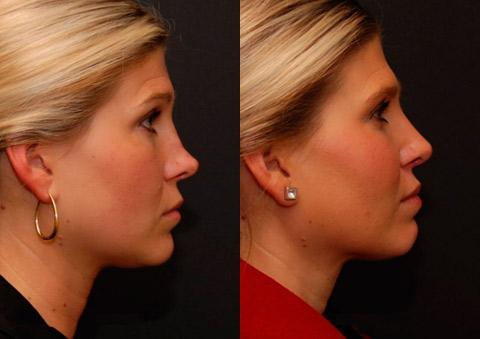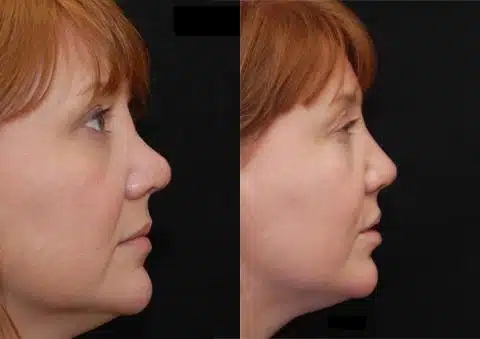Embarking on the journey of nose tip revision, also referred to as primary rhinoplasty, requires a thorough understanding of nasal anatomy and the intricacies of the procedure. Whether addressing concerns stemming from previous surgeries or seeking to improve the nasal tip projection, it’s essential to consider factors like septal cartilage integrity and nasal skin thickness for optimal outcomes. For revision rhinoplasty patients, especially those with a crooked nose or saddle nose deformity, the recovery process may differ from the initial procedure, necessitating careful assessment of medical history and functional aspects like nasal valve collapse.
With the expertise of a double board-certified surgeon and consideration of both cosmetic and functional goals, achieving a natural appearance and improved breathing through techniques such as septal extension grafts or columellar strut grafts becomes attainable, making the dream of a harmonious and feminine nose a reality.

What is a Nose Tip Revision?
Revision rhinoplasty, especially involving the nose tip, addresses residual concerns from primary nose surgeries, whether functional or cosmetic. Surgeons meticulously assess the nasal structure, including the septum, skin, and cartilage, tailoring each procedure to the patient’s needs and desired outcomes. Advanced techniques, such as septal extension grafts or columellar strut grafts, may be utilized to correct issues like nasal valve collapse or a crooked nasal dorsum. Whether opting for an open or closed procedure, the goal remains consistent: achieving a natural appearance with improved breathing functionality. By carefully considering medical history and previous procedures, surgeons strive to deliver the dream nose while mitigating risks associated with revision surgery.
Understanding the Anatomy of the Nose
To truly understand how a revision rhinoplasty surgery works, one must first understand the structure of the nose. Human noses are largely made up of cartilage and skin. The septal cartilage, nasal bridge, and lateral cartilage form the skeletal framework covered by skin. This structure plays a crucial role in nasal function, like nasal breathing.
The nasal tip cartilage also plays a vital role in the overall structure and functionality of the nose. Your surgeon’s skills in manipulating this cartilage are crucial when undergoing a revision procedure. How this cartilage is treated during surgery can also influence your healing process.
Any alterations here can significantly impact a person’s facial features, particularly if surgery leads to nasal obstructions. Moreover, changes could influence the harmony among other facial features, consequently impacting one’s overall facial aesthetics.
Why Might You Need a Nose Tip Revision?
There are various reasons why individuals consider a nose tip revision surgery — both physical and emotional. Some people aim to rectify a crooked nose, reduce a dorsal hump, or simply alter their nose shape to enhance their facial features.
Alternatively, some patients might seek to correct issues from previous rhinoplasties, such as a nasal deformity, loss of nasal function from tissue trauma, or even unnecessary rotation of the nose tip. Breathing issues could also bring patients to this procedure, for example, in cases of external valve collapse or unavoidable obstructions in nasal breathing.
Some individuals might have an over-projected tip that needs correction. Removing cartilage can be a viable option in such cases, but it is essential to balance aesthetics with functionality.
What are the Types of Nose Tip Revision Surgeries?
Revision nose job is a broad term that embraces several procedures. Structurally, they can be categorized into two types: Reconstructive rhinoplasty and cosmetic revision rhinoplasty.
Reconstructive Rhinoplasty
Reconstructive surgery primarily targets nasal function improvement. It helps treat obstructions in nasal passages that could hamper nasal breathing. An experienced reconstructive surgeon designs a surgical plan that would tackle issues like caudal septum abnormalities or might involve cartilage grafts to support areas presenting external valve collapse.
Cosmetic Revision Rhinoplasty
Cosmetic revision rhinoplasty aims to harmonize aesthetic concerns while preserving nasal function, catering to individuals dissatisfied with previous nasal surgeries. Surgical techniques are tailored to each patient’s specific nasal anatomy and history, addressing issues such as dorsal humps, crooked noses, or bulbous nasal tips. Ensuring a natural appearance and improved breathing are primary goals, often requiring intricate maneuvers like septal extension grafts or columellar strut grafts. Given the complexity of revision procedures, selecting a double board-certified surgeon with expertise in cosmetic and functional rhinoplasty is crucial for achieving desired outcomes and minimizing risks associated with nasal valve collapse or septal perforation.
Are There Risks in Nose Tip Revision Surgeries?

Primary rhinoplasty, a facial rejuvenation procedure to enhance nasal aesthetics and function, involves intricate modifications to the nasal tip cartilage, nasal dorsum, and nasal base. However, the procedure can be more complex for revision rhinoplasty patients, those who have undergone previous nose surgeries due to altered nasal anatomy and scar tissue formation. Whether correcting a crooked nose, addressing nasal valve collapse, or refining nasal tip projection, the surgeon must carefully assess the nasal skin, septal cartilage, and nasal sidewalls to achieve a natural appearance and improved breathing.
Understanding one’s medical history, including any previous procedures or nasal trauma, is crucial in determining the optimal surgical approach to address concerns such as a saddle nose deformity or bulbous nasal tip. With meticulous planning and possibly using septal extension grafts or columellar strut grafts, the surgeon aims to create a feminine nose while avoiding complications such as septal perforation or a botched nose job. Thus, for individuals aspiring to attain their dream nose, comprehensive consultations with a double board-certified facial plastic surgeon are essential to discuss expectations, potential risks, and the possibility of a closed procedure versus an open approach.
Preparing for Your Nose Tip Revision Surgery
Preparing for primary or revision rhinoplasty involves thorough discussions with your double board-certified surgeon regarding your nasal anatomy, medical history, and desired outcomes. Comprehensive pre-operative assessments, including photographs and detailed consultations, facilitate a personalized surgical plan tailored to address concerns such as nasal humps, crookedness, or breathing difficulties.
Understanding the proposed surgical techniques, whether open or closed, empowers patients to mentally and physically prepare for their transformative journey toward achieving a natural, balanced nasal appearance and improved breathing function.

The Aftercare to Expect Post Nose Tip Revision
Following primary or revision rhinoplasty, patients undergo a delicate recovery process. Initially, nasal packing supports the newly operated nasal septum and skin. Swelling and bruising are common but typically diminish within a week. However, complete recovery requires patience as septal cartilage settles into its new position and the skin readjusts. Subsequent weeks involve monitoring healing progress through scheduled follow-up appointments with your double board-certified surgeon, ensuring functional and cosmetic success.
What Next After Nose Tip Revision?
In the aftermath of primary rhinoplasty or revision rhinoplasty, as the nasal skin settles and swelling diminishes, monitoring progress through regular documentation with photographs from different angles is crucial. These images serve as valuable tools during follow-up appointments, enabling the double board-certified surgeon to evaluate the evolution of the nasal shape and any improvements in function, particularly for patients with nasal valve collapse or septal perforation. By closely tracking changes and communicating effectively with your surgeon, you ensure that the recovery process aligns with your expectations, whether it involves correcting a crooked nose, addressing a dorsal hump, or enhancing nasal tip projection for a more natural and feminine appearance.
Consult with Dr. Donath
Undergoing an initial or even secondary rhinoplasty is a very personal decision, whether for appearance, nasal breathing, or comfort. One must ensure they are in the safe and competent hands of a facial plastic surgeon with deep understanding and exceptional skills, like Dr. Donath. With years of experience in nose surgery, you can rest assured that your needs will be met and your desired results achieved. Schedule a consultation today to find out how he can help you reach your goals.


